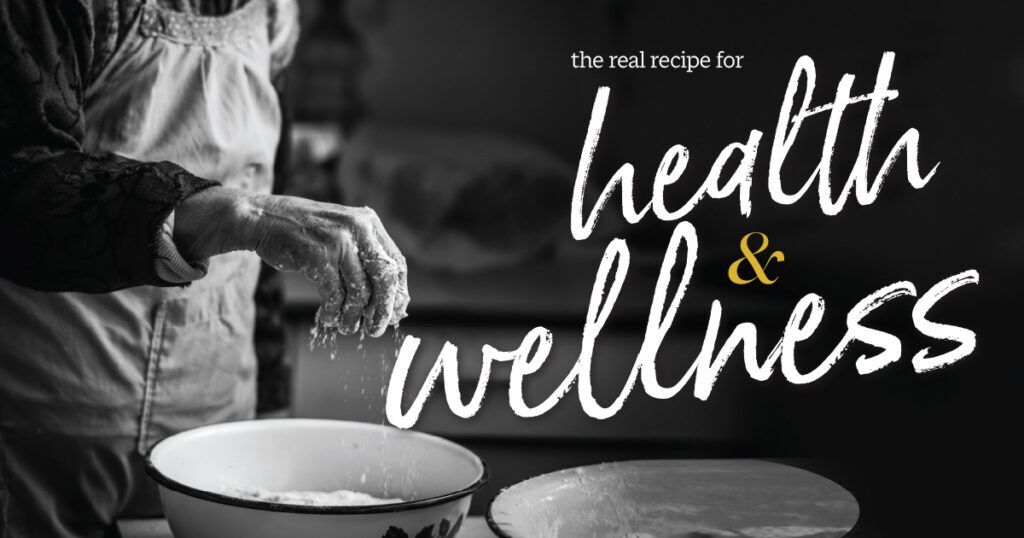09 Oct 2023 The real recipe for health and wellness
By Vivian L. Hogue
No one had to tell us when supper was ready (that’s “dinner” outside the South). Whatever it was could probably be detected as far as the Spatz’s house. But mother would come to the patched, back-screened door and yell, “Viv-YUN! No-UHL!” Her first call was her only call, so we and likely several mosquitoes and flies came streaming in. Over the door’s kick plate we could see cat and dog tails waving like the last stage of an automatic car wash.

The three older brothers were off gallivanting with their school attendance, friends and projects. Noel and I, the “second family” by age and circumstance, were next for our parents to try and figure out. Not amazing, however, since Noel and I couldn’t figure out each other, either. There was one thing we all agreed upon—that being that mother was a great cook. She could even feed what seemingly were the “5,000” with something, even if the “fish” ran out. If guests arrived unannounced, she would simply tie her apron strings tighter and start her magic. Just as with her sewing, she could make something out of nothing. You might not get something elegant, but she was gladly going to feed you.
I often think of my womenfolk ancestors when the news speaks of non-GMOs, food recalls, shortages of eggs and gut diseases acquired from restaurants. My grandmother Lawson would have asked where you “git sich i-dees.” With no running water, she washed her hands in the white porcelain bowl with red trim, but bacteria were not her concern. Washing the stuff off her hands and her own hen eggs was.
They were careful about processing their cows’ milk, separating the cream and making butter. With no refrigeration except for the spring house and the cool creek that ran through it, the milk and hand-formed butter were kept there. The spring water was sweet with magnesium and 55 degrees all year. The family and any visitors were welcome to use the same dipper that hung outside the door.
Each of our grandmothers made foods on which they were raised. Grandmother Arnold was an Arkansan, but Granddad was Kentucky-born and -bred, yet there were similar preferences. It was still corn pones, pork, beef, squirrel, rabbit, chicken and plenty of vegetables. I was shocked to find that dandelions made good tea and nasturtium blooms were tasty. Desserts were mostly fruit-based, but Grandmother Arnold baked chess and buttermilk pies, while my hill country grandmother made Tennessee stack cakes and vinegar pies. Ingredients for all were simple, affordable, moderately sweet and what was on hand.
Did you notice there was no high fructose syrup? No aspartame? No thiamine mononitrate, soybean oil, soy lecithin or FD&C blue No. 1 or FD&C yellow No. 6? How about monosodium glutamate or its twin, yeast extract? “Natural” flavors? Are original flavors not enough? What kind of “natural” is it, exactly?
One of mother’s dishes was always anticipated. She made the corn pones, but got the idea of stacking them with chili in between and topping with cheese. She made Franke’s Restaurant Eggplant Casserole when few knew what an eggplant was.
Mother’s cooked grits, when congealed, sliced, dipped in egg and fried, is one of my son’s and my favorites. I also liked her bread pudding and all the ways of cooking okra (pronounced “okry”). Oh, and the speed with which her peanut butter fudge disappeared was something to behold.
Getting back to real cooking for our families is more than a good idea. Teach children how to cook as soon as you can and show them what real food is. It doesn’t come in wrappers and isn’t made by hands you don’t see. It doesn’t contain all those ingredients of dubious origins. (There’s a reason a “processed cheese product” is called “liquid plastic.”) Many people cook a whole, healthy meal in an appliance while they’re at work and the kids are in school! You could even have a small garden just for them to grow and learn about what they eat (for example, tomatoes become ketchup).
I once spoke of mother baking a sizable, delicious roast for a large table of guests. I was always her “sous chef,” so I was to assist in taking the heavy roast out when the timer rang. Many years later, I now admit that the roast slid off the platter and onto the floor. Thank goodness for loud table conversation as we bent down behind the cookstove laughing. I whispered, “What do we do NOW??!!” She picked it up, washed it off, returned it to the platter and poured hot broth over it. Oh, what lavish compliments were offered! She just blushed, looked at me and said, “Oh, well, it took both of us.” And, indeed, it did.
- Salute to service - June 30, 2024
- One man plus One idea equals a 149-year-old city - June 2, 2024
- A look back at the forgotten women of the 501 - April 30, 2024











